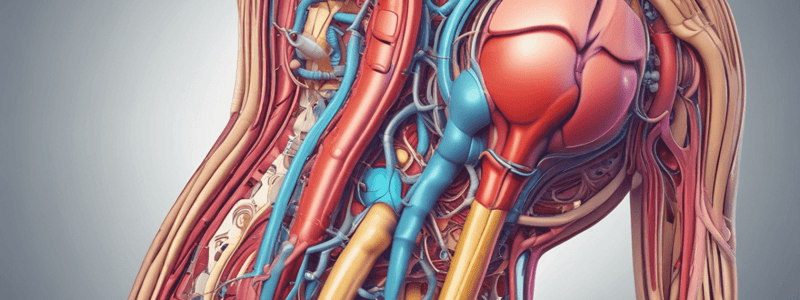Podcast
Questions and Answers
What is the main function of the urinary system?
What is the main function of the urinary system?
- Production of erythropoietin
- Regulation of electrolyte balance
- Regulation of blood pressure
- Removal of toxic waste. Regulation of blood volume, pressure, and composition Regulation of the acid-base balance of the blood Regulation of Electrolyte Balance Production of erythropoietin Activation of vitamin D 2 (correct)
What is the function of the ureters
What is the function of the ureters
- Eliminates waste products from the body
- Reservoir for urine
- Carry Urine from Kidneys to Bladder – Narrow point where each ureter joins the renal pelvis is the uretropelvic junction (UPJ) – Point where each ureter inserts in the side of the bladder base is the ureterovesical junction (UVJ) (correct)
- Point where each ureter inserts in the side of the bladder base
What controls voiding in the urethra? and its functions
What controls voiding in the urethra? and its functions
- Afferent arteriole
- Carry urine from bladder to outside of body • Controls voiding via internal and external sphincters Length • Female: 1-2 inches • Male: 8-10 inches (correct)
- Renal vein
- Internal sphincter
what is the elctrolyte balance
what is the elctrolyte balance
Which part of the urinary system serves as a reservoir for urine?
Which part of the urinary system serves as a reservoir for urine?
Where is the urethral meatus positioned in hypospadias?
Where is the urethral meatus positioned in hypospadias?
In epispadias, where is the urethral meatus located?
In epispadias, where is the urethral meatus located?
What is the normal range for glomerular filtration rate (GFR)?
What is the normal range for glomerular filtration rate (GFR)?
Which of the following substances normally filters into urine during glomerular filtration?
Which of the following substances normally filters into urine during glomerular filtration?
What is the specific gravity range considered normal in urinalysis?
What is the specific gravity range considered normal in urinalysis?
What does not cross into tubules in normal GFR
What does not cross into tubules in normal GFR
In a clean catch specimen for urinalysis, what is the correct procedure after initially voiding in the toilet?
In a clean catch specimen for urinalysis, what is the correct procedure after initially voiding in the toilet?
What is reabsorbed into the blood during normal GFR
What is reabsorbed into the blood during normal GFR
Lab tests of urinalysis
Lab tests of urinalysis
What is considered a normal specific gravity range in urinalysis?
What is considered a normal specific gravity range in urinalysis?
What is the culture and sensitivity test
What is the culture and sensitivity test
What are renal function test
What are renal function test
What is a potential cause of contrast-induced nephropathy?
What is a potential cause of contrast-induced nephropathy?
What is the purpose of an Intravenous Pyelogram (IVP) in radiologic studies?
What is the purpose of an Intravenous Pyelogram (IVP) in radiologic studies?
What are pediatric considerations
What are pediatric considerations
What does a Kidneys-Ureter-Bladder (KUB) X-ray primarily show in pediatric radiologic studies?
What does a Kidneys-Ureter-Bladder (KUB) X-ray primarily show in pediatric radiologic studies?
What are renal diagnostic test
What are renal diagnostic test
What type of urinary incontinence is characterized by involuntary urine loss with abrupt/strong desire to void?
What type of urinary incontinence is characterized by involuntary urine loss with abrupt/strong desire to void?
Which type of urinary incontinence is linked to impairment of physical or mental function rather than a problem with the urinary system itself?
Which type of urinary incontinence is linked to impairment of physical or mental function rather than a problem with the urinary system itself?
What type of urinary incontinence involves involuntary loss of urine associated with bladder overdistention?
What type of urinary incontinence involves involuntary loss of urine associated with bladder overdistention?
Which condition is characterized by continuous, unpredictable loss of urine?
Which condition is characterized by continuous, unpredictable loss of urine?
What is the common symptom associated with urinary retention regarding bladder distention?
What is the common symptom associated with urinary retention regarding bladder distention?
Urinary retention UOP
Urinary retention UOP
Baldder distension in urinary retention
Baldder distension in urinary retention
What is the primary use of bladder scan
What is the primary use of bladder scan
What is treatment for urinary retention
What is treatment for urinary retention
What is a never event for catheter associated urinary tract infections (CAUTI)
What is a never event for catheter associated urinary tract infections (CAUTI)
What is the recommended frequency for performing intermittent catheterization?
What is the recommended frequency for performing intermittent catheterization?
More info about urinary catheters
More info about urinary catheters
More urnary catheters
More urnary catheters



